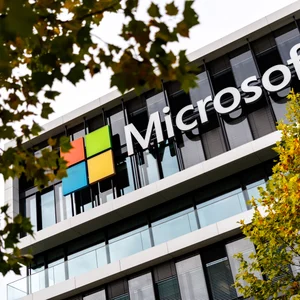Copyright qz

Microsoft ended the day the way only a $4 trillion company could: with an outage — and an earnings beat. Hours after parts of Azure, 365, and Xbox flickered offline, the company reported revenue of $77.7 billion for its fiscal first quarter of 2026 — up 18% year over year — and adjusted EPS of $4.13, topping Wall Street’s $3.67 estimate. Suggested Reading Operating income rose 24% year over year to $38 billion, proof that even record spending hasn’t dented Microsoft’s ability to scale profit alongside infrastructure. But Microsoft booked a $3.1 billion charge tied to its OpenAI investment this quarter, and gross margin slipped slightly to 69% as AI investments outpaced efficiency gains. Still, taken together, the numbers, which marked yet another earnings beat, landed like a reminder: When your platform runs half the digital economy, even a bad day still prints money. Related Content Shares slipped almost 4% in after-hours trading, a sign that Wall Street’s expectations were already high — and that investors wanted more than another quarter of cloud growth and capex promises. But even as investors weighed the cost of momentum against returns, the quarter answered a key question: Is all that capex translating into demand? So far, yes. “Demand is increasing,” chief financial officer Amy Hood said on the call. “It is not increasing in just one place; it’s increasing across many places. We’re seeing usage increases in products, new products launched that are getting usage very quickly. When people see real value, they actually commit real usage.” The quarter looked like power-forward momentum in the enterprise cloud era: revenue above expectations, cloud growth re-accelerating, and a backlog so large it suggests the company is entering a different league. The cloud business remains the locomotive. Microsoft Cloud revenue surged around 26% to $49.1 billion, and Azure-related services grew about 40% year over year, keeping Microsoft squarely in the AI-infrastructure slipstream. Azure’s growth included a sizable lift from AI-related workloads, now embedded across the product stack as Copilot adoption spreads through Office, GitHub, and enterprise software suites. Microsoft now sees Azure growing about 37% this coming quarter — fast enough to keep the company bumping up against its own power limits. The company said on the post-release earnings call that “demand again exceeded supply across workloads,” and Microsoft now expects to be capacity-constrained through at least the end of its fiscal year. CEO Satya Nadella said on the earnings call that the company “say[s] no to some of the demand that may be something that we could serve, but it’s not in our long-term interest.” But capital spending swelled to roughly $35 billion — an all-time high — as the company poured money into data centers, power capacity, GPUs, and CPUs to meet AI demand that still outpaces supply. Free cash flow rose 33% year over year to $25.7 billion, underscoring that Microsoft’s cash engine is still running even as capex explodes. “With accelerating demand and a growing RPO balance, we’re increasing our spend on GPUs and CPUs,” the company said on the call. “Therefore, total spend will increase sequentially, and we now expect the FY26 growth rate to be higher than FY25.” For the current quarter, Microsoft guided total revenue to about $79.5–$80.6 billion, with operating margin roughly flat year over year and down sequentially on seasonality. Hood added, “When you see these kinds of demand signals, and we know we’re behind, we do need to spend, but we’re spending with a different amount of confidence in usage patterns and in bookings, and I feel very good about that.” Commercial bookings soared 112%, largely on OpenAI’s Azure commitments — and the quarter doesn’t yet reflect the additional $250 billion deal announced this week. Yesterday, Microsoft locked in its stake in OpenAI — roughly 27% of the for-profit arm, valued at about $135 billion — alongside a $250 billion Azure services commitment and rights that extend into 2032. The deal tightens Redmond’s grip on the AI value chain: OpenAI’s essentially guaranteed cloud spend effectively underwrites Microsoft’s infrastructure expansion while preserving access to OpenAI models through 2032; Microsoft also dropped its right of first refusal on OpenAI’s cloud, easing exclusivity. The infrastructure build-out now gets a commercial anchor, not just a promise. The numbers themselves were solid. Beyond the clear cloud re-acceleration, Intelligent Cloud revenue jumped 28% to $30.9 billion, driven by Azure and a surge in AI-enabled workloads, and the company’s commercial remaining performance obligations — effectively its cloud backlog — surged 51% to $392 billion, highlighting just how much future revenue is locked in. The balance has nearly doubled over the past two years, with a weighted-average duration of about two years. The pipeline is now big enough to be its own moat. Productivity and Business Processes — home to Microsoft 365, LinkedIn, and Dynamics — grew about 17% to $33 billion. More Personal Computing ticked up around 4% to $13.7 billion, helped by Windows and Surface, though gaming remains in flux. In fact, gaming was one of the few soft spots — revenue slipped roughly 2% from a year earlier as console sales sagged, partly offset by a small uptick in Xbox content and services. Within Productivity, commercial-cloud revenue rose 17%, and consumer-cloud revenue 26%, fueled by the rollout of Copilot features across 365. CEO Satya Nadella framed the quarter in the accompanying press release as one of scaling the “planet-scale cloud and AI factory” that is “driving broad diffusion and real-world impact,” and CFO Amy Hood called it “a strong start to the fiscal year.” Microsoft returned $10.7 billion via buybacks and dividends in the quarter. The company continues to guide qualitatively on the call rather than in the release, but the growth mix — Azure re-acceleration plus swelling backlog — keeps the AI-data-center flywheel turning. That confidence comes at a price. Microsoft is still spending heavily to keep its lead in AI infrastructure, and that spending is tightening margins. Capex remains steep as the company races to add power capacity and GPUs faster than customers can consume them. The setup may be enviable — demand exceeds supply — but it also limits near-term operating leverage. The outage that preceded the results didn’t help the optics. Hours before the print, a configuration change in Azure Front Door triggered a wide outage that rippled through Microsoft 365, Xbox, and other services. Microsoft said it rolled out a fix, and traffic was rerouted to restore service. The timing was almost allegorical — even one of the biggest names in cloud computing can trip over its own wiring. For a company now worth more than $4 trillion, the bar keeps rising faster than the guidance. Microsoft delivered growth, scale, and another clean beat — and still wasn’t able to completely convince the market that it was enough. But the earnings make it clear that Microsoft isn’t merely chasing cloud growth. It’s building a base so large that the challenge now shifts from “Can we grow?” to “How fast can we monetize that growth and embed deeper?” Outage day or not, the moment here is scale. 📬 Sign up for the Daily Brief



